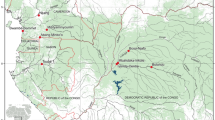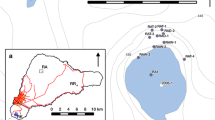Abstract
Plant communities of ancient banded iron formation ranges of South Western Australia occur as islands in a matrix of the largest remaining area of Mediterranean woodlands and shrub lands on the planet. These xeric shrub lands are structurally and compositionally different from the surrounding matrix and exhibit high levels of endemism and species turnover that cannot be ascribed to geology or current climatic gradients. The pattern of the vegetation and flora on these ranges appears to be related to local topographical factors and the long period of time these landscapes have remained unglaciated and above sea level. Similar patterns have recently been described for iron outcrop communities in Brazil. In both regions these communities are being significantly impacted by mining. The high correlation between local endemism and restricted plant communities and high grade mineral deposits presents difficult challenges for achieving a comprehensive, adequate and representative reserve system in South Western Australia.






Similar content being viewed by others
Abbreviations
- BIF:
-
Band iron formation
- Nmds:
-
Nonmetric multidimensional scaling
- PCNM:
-
Principal coordinates of neighbor matrices
- Prda:
-
Partial redundancy analysis
- R 2a :
-
Adjusted R 2
- SWAFR:
-
South West Australian Floristic Region
References
Anderson MJ, Gorley RN, Clarke KR (2008) PERMANOVA+ for PRIMER: guide to software and statistical methods. Primer-E, Plymouth
Beard JS (1990) Plant life in Western Australia. Kangaroo Press, Perth
Borcar D, Legendre P, Avois-Jacquet C et al (2004) Dissecting the spatial structure of ecological data at multiple scales. Ecology 85:1826–1832
Borcard D, Legendre P (2002) All-scale spatial analysis of ecological data by means of principal coordinates of neighbour matrices. Ecol Model 153:51–68
Bray RJ, Curtis JT (1957) An ordination of the upland forest communities of southern Wisconsin. Ecol Monogr 27:325–349
Butcher R (2007) New taxa of ‘leafless’ Tetratheca (Elaeocarpaceae, formerly Tremandraceae) from Western Australia. Aust Syst Bot 20:139–160
Butcher R, Byrne M, Crayn DM (2007) Evidence for convergent evolution among phylogenetically distant rare species of Tetratheca (Elaeocarpaceae, formerly Tremandraceae) from Western Australia. Aust Syst Bot 20:126–138
Butcher PA, McNee SA, Krauss SL (2009) Genetic impacts of habitat loss on the rare ironstone endemic Tetratheca paynterae subsp. paynterae. Conserv Genet 10:1735–1746
Butler DW, Fensham RJ (2008) Lose the plot: cost effective survey of the Peak Range, Central Queensland. Cunninghamia 10:521–538
Byrne M, Hopper SD (2008) Granite outcrops as ancient islands in old landscapes: evidence from the phylogeography and population genetics of Eucalyptus caesia (Myrtaceae) in Western Australia. Biol J Linn Soc 93:177–188
Byrne M, Yeates DK, Joseph L et al (2008) Birth of a biome: insights into the assembly and maintenance of the Australian arid zone biota. Mol Ecol 17:4398–4417
Clarke KR, Gorley RN (2006) PRIMER v6: user manual/tutorial. Primer-E, Plymouth
Commonwealth of Australia (1999) Guidelines for establishing the National Reserve System. Environment Australia, Canberra
Commonwealth of Australia (2009) Australian atlas of minerals resources, mines and processing centres. http://www.australianminesatlas.gov.au/aimr/commodity/iron_ore_09.jsp Accessed 11 March 2010
Commonwealth of Australia (2010) Australian mineral statistics 2010. December quarter 2009. Australian Bureau of Agricultural and Resource Economics, Canberra
Danin A (1999) Desert rocks as plant refugia in the near East. Bot Rev 65:93–170
Garcia LC, Barros FV, Lemos-Filho JP (2009) Fructification phenology as an important tool in the recovery of iron mining areas in Minas Gerais, Brazil. Braz J Biol 69:887–893
Gibson N, Coates DJ, Thiele KR (2007) Taxonomic research and the conservation status of flora in the Yilgarn banded iron formation ranges. Nuytsia 17:1–12
Hijmans RJ, Cameron SE, Parra JL et al (2005) Very high resolution interpolated climate surfaces for global land areas. Int J Climatol 25:1965–1978
Hocking RM, Langford RL, Thorne AM, et al. (2007) A classification system for regolith in Western Australia (March 2007 update). Western Australia Geological Survey, Record 2007/8, 19 p
Hopper SD (1979) Biogeographical aspects of speciation in the South West Australian flora. Annu Rev Ecol Syst 10:399–422
Hopper SD (2009) OCBIL theory: towards an integrated understanding of the evolution, ecology and conservation of biodiversity on old, climatically buffered, infertile landscapes. Plant Soil 322:49–86
Hopper SD, Gioia P (2004) The Southwest Australian floristic region: evolution and conservation of a global hot spot of biodiversity. Annu Rev Ecol Evol Syst 35:623–650
Hopper SD, Brown AP, Marchant NG (1997) Plants of Western Australian granite outcrops. J R Soc West Aust 80:141–158
Hubbell SP (2001) The unified neutral theory of biodiversity and biogeography. Princeton University Press, Princeton
Jacobi CM, Carmo FF (2008) The contribution of ironstone outcrops to plant diversity in the Iron Quadrangle, a threatened Brazilian landscape. Ambio 37:324–326
Jacobi CM, Carmo FF (2009) Pollination and seed dispersal syndromes in plant communities on ironstone outcrops, SE Brazil. Paper presented at Anais do III Congresso Latino Americano de Ecologia, São Lourenço, Brasil, 10–13 September 2009
Jacobi CM, Carmo FF, Vicent RC et al (2007) Plant communities on ironstone outcrops: a diverse and endangered Brazilian ecosystem. Biodivers Conserv 16:2185–2200
Jansson R (2003) Global patterns in endemism explained by past climatic change. Proc Biol Sci 270:583–590
Judd S, Watson JEM, Watson AWT (2008) Diversity of a semi-arid, intact Mediterranean ecosystem in Southwest Australia. Web Ecol 8:84–93
Keighery G (1993) Flora list for the Stirling Range National Park. CALM, Como
Legendre P, Borcard D, Peres-Neto PR (2005) Analyzing beta diversity: partitioning the spatial variation of community composition data. Ecol Monogr 75:435–450
Markey AS, Dillon SJ (2008a) Flora and vegetation the banded ironstone formation of the Yilgarn Craton: the Central Tallering land system. Conserv Sci West Aust 7:121–149
Markey AS, Dillon SJ (2008b) Flora and vegetation the banded ironstone formation of the Yilgarn Craton: Weld Range. Conserv Sci West Aust 7:153–178
McLoughin S (2001) The breakup history of Gondwana and its impact on pre-Cenozoic floristic provincialism. Aust J Bot 49:271–300
Meissner R, Caruso Y (2008a) Flora and vegetation of the banded ironstone formation of the Yilgarn Craton: Koolanooka and Perenjori Hills. Conserv Sci West Aust 7:73–88
Meissner R, Caruso Y (2008b) Flora and vegetation of the banded ironstone formation of the Yilgarn Craton: Mt Gibson. Conserv Sci West Aust 7:105–120
Mourão A, Stehmann JR (2007) Levantamento da flora do campo rupestre sobre canga hematítica couraçada remanescente na Mina do Brucutu, Barão de Cocais, Minas Gerais, Brasil. Rodriguésia 58:775–786
Oksanen J, Kindt R, Legendre P, et al. (2009) The vegan package. http://vegan.r-forge.r-project.org/. Accessed 10 March 2010
Peres-Neto PR, Legendre P, Dray S et al (2006) Variation partitioning of species data matrices: estimation and comparison of fractions. Ecology 87:2614–2625
Porembski S (2007) Tropical inselbergs: habitat types, adaptive strategies and diversity patterns. Rev Bras Bot 30:579–586
Scarano FR (2007) Rock outcrop vegetation of Brazil: a brief overview. Rev Bras Bot 30:561–568
Viana PL, Lombardi JA (2007) Florística caracterização dos campos rupestres sobre canga na Serra da Calçada, Minas Gerais, Brasil. Rodriguésia 58:159–177
Whittaker RH (1956) Vegetation of the Great Smoky Mountains. Ecol Monogr 26:1–80
Yates CJ, Ladd PG, Coates DJ et al (2007) Hierarchies of cause: understanding rarity in an endemic shrub Verticordia staminosa (Myrtaceae) with a highly restricted distribution. Aust J Bot 55:194–205
Acknowledgments
We would like to thank Vanessa Clarke for assistance in the field. This work was partially funded by Portman Iron Ore Ltd. We thank Piers Goodman (Portman Ltd) for supporting this research and James Hesford (Portman Ltd) for managing our visits to Windarling Ridge.
Author information
Authors and Affiliations
Corresponding author
Rights and permissions
About this article
Cite this article
Gibson, N., Yates, C.J. & Dillon, R. Plant communities of the ironstone ranges of South Western Australia: hotspots for plant diversity and mineral deposits. Biodivers Conserv 19, 3951–3962 (2010). https://doi.org/10.1007/s10531-010-9939-1
Received:
Accepted:
Published:
Issue Date:
DOI: https://doi.org/10.1007/s10531-010-9939-1




